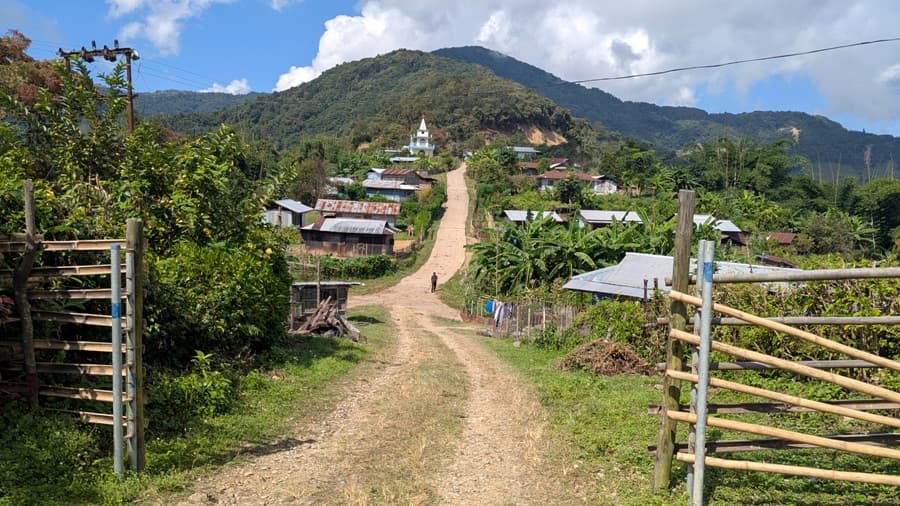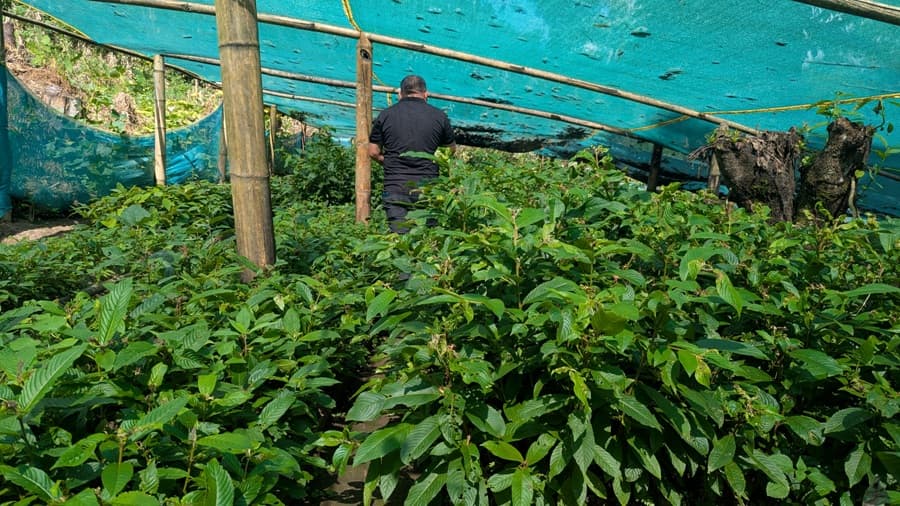TUESDAY, NOVEMBER 11, 2025
- Home
- Mountains to Mangroves: Three Nagaland villages, one green vision
Mountains to Mangroves: Three Nagaland villages, one green vision
Three Zunheboto villages revive forests through community conservation and agroforestry under the Mountains to Mangroves climate campaign.
Share
In Zunheboto’s Tizu Valley, communities lead the way in rewilding land and rewriting their ecological story

KOHIMA — For the three neighbouring villages of Sükhai, Kivikhu and Ghukhuyi in Zunheboto district, conservation is not a new vocabulary but a decade-old practice shaped by local resolve.
Long before state-led programmes reached their landscape, the villages decided in 2014 to protect their forests and convert their traditional hunting grounds into Community Conserved Areas (CAA). Together, they now protect about 1,700 hectares that are home to species such as the Blyth’s tragopan, fishing cat and wild dogs along the Tizu River.
Before the push for conservation, the region faced forest loss, uncontrolled hunting, soil erosion and over-extraction of resources.
Sükhai first declared its conservation area, later joined by Kivikhu and Ghukhuyi, forming the Tizu Valley Biodiversity Conservation and Livelihood Network (TVBCLN). Since then, they have worked with conservation groups within and outside Nagaland to strengthen community-led efforts.
The Energy and Resources Institute (TERI) has been one of the earliest partners, helping the communities establish their conservation areas, prepare people’s biodiversity registers and begin biodiversity monitoring. Over the years, the villages have recorded more than 200 species of birds and a similar number of butterflies, along with rediscoveries and new observations.
Arrival of MTM campaign
In 2024, a new phase of conservation arrived through the Mountains to Mangroves (MTM) campaign. “The campaign connects mountain ecosystems to mangrove forests, creating an integrated approach to climate resilience, biodiversity conservation and community well-being,” Conservation International told Eastern Mirror.
The campaign aims to restore one million hectares of forest and plant one billion trees across the Eastern Himalayas, including Nagaland, by 2030.

According to TERI, the MTM has two components: restoration via tree plantation, and forest protection and conservation. The tree plantation and agroforestry component is being implemented in Sükhai, Kivikhu and Ghukhuyi.
It is supported by Conservation International and implemented by TERI with TVBCLN as a partner. Towards this, more than 1.2 lakh native saplings have been planted, with 30,000 each in Kivikhu and Ghukhuyi and 60,000 in Sükhai.
This newspaper visited Sükhai on October 25 to interact with locals and assess the project’s progress on the ground.
One of the major plantation and agroforestry sites lies on Sükhai’s active jhum fields, only a kilometre away from the village. This 120 to 130 hectare area sustains local livelihoods, making restoration both sensitive and significant.
Team leader Ivan Zhimomi said that the idea was to introduce habitat restoration after cultivation, which is a shift from the traditional method of leaving jhum fields to regenerate naturally. Under the campaign, these fallows are being converted into agroforestry.
Also read: Building on the Past: Mimi village sustains its stone slate roofing heritage
“This is the first time we are doing habitat restoration on jhum fallows,” he said. “The main purpose is quick regeneration of abandoned jhum, to reduce soil erosion and support water conservation and biodiversity.” Saplings planted in May and June had already grown up to five feet by late October.
According to Zhimomi, discouraging jhum outright is neither realistic nor culturally respectful. “As Nagas, how can we stop farmers from cultivating?” he said, adding that restoring cultivated land by planting trees offers a practical middle path.
Community involvement
A dedicated nursery has been set up near Sükhai, where about 14 villagers collect seeds, raise saplings and distribute them for planting across the three villages.
Tolika, one of the workers, said that the team began by clearing and preparing the nursery last year, followed by seed collection and sowing in January and February and consistent watering. “We sowed about two lakh seeds,” she said. The saplings were later packed and supplied to the villages.

Zhimoholi, who previously worked with another organisation on a similar project, now helps manage both the nursery and the plantations on jhum land. She said that some saplings have grown well while others have had to be replaced.
Agroforestry, she shared, offers added benefits such as fruit for families, improved air quality and better soil health. “I hope the trees we planted this time will bear fruit,” she said.
In the words of Conservation International, the initiative combines agroforestry, regenerative agriculture and forest restoration to strengthen biodiversity and support local livelihoods. “These interventions directly support communities like Sükhai, which have a long tradition of community-based forest management,” it stated.
Dr. Alark Saxena, Associate Professor at the School of Forestry, Northern Arizona University, described the initiative as more than planting trees.
“Mountains to Mangroves represents the kind of collaborative model that conservation science has always aimed to achieve. It’s not just about planting trees, but about rebuilding relationships between people and ecosystems,” he said.
Read more: GST reforms to boost Nagaland’s economy across key sectors
According to TERI, which has worked with Sükhai since 2014-2015, the forests of Sükhai and the larger project landscape face drivers of degradation, including jhum, mining and unsustainable forest extraction. Limited infrastructure, lack of alternative livelihood options and market access also increase dependence on forest resources.
The campaign’s blend of restoration and livelihood support aims to address these challenges.
Storytelling as conservation
The implementing partners of MTM campaign have also partnered with People Like Us Create (Pluc) TV, a storytelling platform that trains communities to document and share their own stories.
A three-member team led by founder and CEO Tamseel Hussain visited Sükhai on October 25 and 26 to document stories of the community. Pluc TV has trained over 300,000 creators worldwide, including storytellers from Sükhai.
Hussein said that while the campaign revives conservation efforts, storytelling revives cultural memory. “Nagaland is full of culture, and it needs a way for the world to connect with it beyond Hornbill,” he said. He added that storytelling could help communities revive traditions, transfer knowledge and draw attention to conservation.
Meanwhile, Zhimomi said that planting trees remains the most practical response to water scarcity, soil infertility, climate change and the loss of biodiversity. Conservation, he said, is ultimately an obligation to nature and to future generations.
(This report is the first in a two-part series on the Mountains to Mangroves campaign in Zunheboto.)

